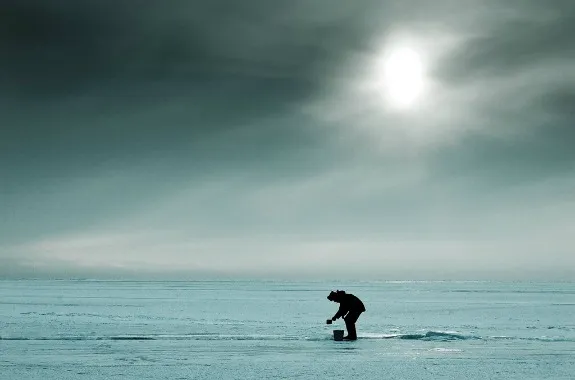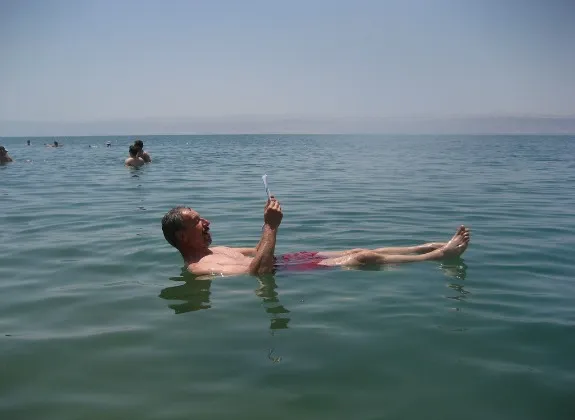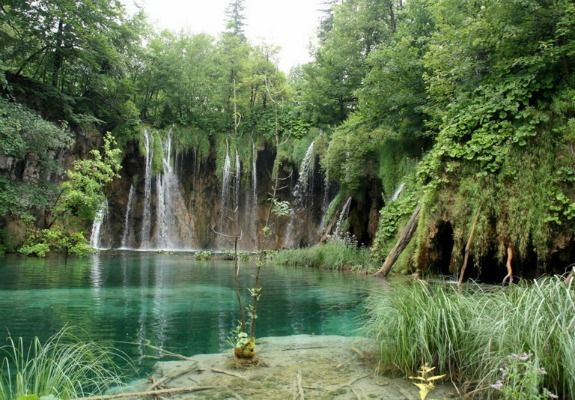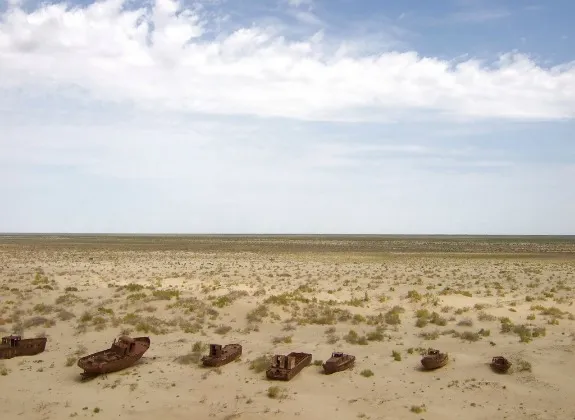Lake Baikal and More of the Weirdest Lakes of the World
Set deep within the Russian subcontinent, Baikal is the deepest, oldest and most voluminous of all lakes
/https://tf-cmsv2-smithsonianmag-media.s3.amazonaws.com/filer/20120807025030LakesBaikalSpitSMALL.jpg)
No lake is more lake than Lake Baikal. Set deep within the Russian subcontinent, Baikal is the deepest, oldest and most voluminous of all lakes, a superstar of superlatives in hydrology, geology, ecology and history. The lake is more than 5,300 feet deep (exact figures vary) at its most profound point, which lies about 4,000 feet below sea level. With 12,248 square miles of surface area, Baikal averages 2,442 feet deep—its crescent moon-shaped figure a vast rift valley that first appeared about 25 million years ago through the divergence of the planet’s crust. Today, Lake Baikal contains some 20 percent of the earth’s lake and river water, making this Russian giant comparable in volume to the entire Amazon basin. So huge is Baikal that it reportedly takes an average of 330 years for a single water molecule to flow through it, from inlet to outlet. Lake Baikal features 27 islands, including one 45 miles in length called Olkhon, while in and around Baikal live more than 1,500 animal species, about 80 percent of which live nowhere else on the planet.
The most famous of these animals may be the nerpa, the only exclusively freshwater seal on the planet. The nerpa numbers an estimated 100,000—a comfortable and well-adapted population of animals whose presence in interior Russia has stumped evolutionary biologists, who aren’t certain when or just how the animals came to be so far from the open ocean. Guided tourist outfits can provide visitors with views of the animals, though the seals are generally skittish around people, who have long hunted them for pelts, fat and flesh. Brown bears and wolves dwell near the lake, too, occupying the top tiers of the Siberian food chain, as do a variety of deer, birds, rodents and smaller predators.

The first European to visit Lake Baikal may have been Russian Kurbat Ivanov, in 1643, though local lore claims that Jesus took a short walk to Lake Baikal and back during his days of desert wandering. Today, a wilderness of forest, plains and semidesert surrounds Baikal in the grand landscape of Siberia, though development along the shores of the lake occurred last century with the building of several urban and resort communities. Ugliest, perhaps, among the defilements of Baikal’s coastline is a paper mill that discharged pollutants into Baikal for years before being closed in 2008 on grounds of ecological protection. But the mill reopened in 2010, supposedly using cleaner and safer practices than previously. Meanwhile, local conservationists have other causes of concern. They have, for example, resisted plans to build a uranium plant in the nearby city of Angarsk. And they raised a stink when a petroleum development company called Transneft nearly built an oil pipeline that would have passed within 3,000 feet of Lake Baikal, threatening its waters with leaks and spills. The planned pipeline route was eventually changed. Tourism development is a minor itch in comparison, though it may produce eyesores like the hotels and vacation communities of Listvyanka, a popular winter and summer tourist town.
If you visit Lake Baikal, remember that winters here are frigid and icebound, with continental cold snaps bringing temperatures as low as minus 40 degrees Fahrenheit and producing a layer of surface ice as thick as two meters. Summertime is friendlier, offering long, long days and superb opportunities for hiking, biking, camping and fishing. Along the lake’s northern shore, the Frolikha Adventure Coastline Track leads 65 miles through the wilderness. How to reach Lake Baikal? Try the legendary Trans-Siberian Railway.
Other Weird Waters
Dead Sea. Almost nine times as salty as the ocean, with a salinity level of about 30 parts per hundred, the Dead Sea—the lowest point on earth—is inhospitable to nearly all living things, but it’s a blast to bathe in. The water’s salt-boosted density is so great that people endowed with a generous layer of body fat can hardly swim and may merely flail over the surface as if they were crawling across a sandy dune. Better not to try and, instead, just turn over on your back and enjoy the bizarre wonder of a lake in which it may be almost impossible to drown. The Dead Sea’s surface lies 1,378 feet below sea level, and it is 1,083 feet deep. This just in: Life-forms have been found associated with freshwater springs at the bottom of the Dead Sea. Time for a name change?

Lake Titicaca. At 12,500 feet above sea level in a high valley in the Andes Mountains, the giant Lake Titicaca is the loftiest lake commercially navigable by large boats and contains more water than any other lake in South America. Its two main ports are Puno, Peru—a beautiful old town steeped in Incan history—and Challapampa, Bolivia. Isla del Sol is an island on Titicaca’s Bolivian side. Strewn with ruins but without a single paved road, this large island is an adventurer’s playground. Get yourself a fishing rod and a canoe, and go.
Melissani Cave Lake. Locals allegedly knew about the Melissani Cave Lake in Greece all along, but if they did, the world never heard about it until 1953, when an earthquake caused a collapse of rock, exposed the crystal-clear lake and brought sunlight and color to its waters for the first time. The lake has since gained fame—and it happens to be located on the island that Homer named as the home country of Odysseus.
Wuhua Hai Lake. Widely lauded as one of the most beautiful lakes on earth, Wuhua Hai is located in Jiuzhaigou Nature Reserve, in the high mountains of Sichuan, China. The waters are emerald blue and clear as air, and over the shallow lake bed lie scores of sunken logs visible from above the surface. Forested mountain slopes rise from the lake’s shore, and wild pandas dwell in the woods.

Plitvice Lakes. A chain of 16 lakes connected by streams, caves and waterfalls, the Plitvice Lakes of Croatia gleam in a spectrum of blue to azure colors and demonstrate beautifully what water, nature’s finest sculptor, may make of a soft basin of limestone. The dense green woods surrounding the lakes are home to bears, wolves, eagles and numerous other creatures protected in this national park and Unesco World Heritage site.
Aral Sea. A reminder of the devastating effects of agriculture gone haywire, the Aral Sea in Uzbekistan has just about dried up since 1960. The two rivers that fed this once-giant inland sea (330 rivers feed Baikal, for comparison) no longer get there, diverted to fields instead. And while the Aral’s blue ovoid shape still appears on most world maps, cartographers must surely soon realize that the sea, once one of the largest and most productive inland waterways and fisheries, has all but dried up, sacrificed over a mere 50 years for the sake of local cotton and rice.

Salton Sea. This lake in southern California’s Imperial Valley is another testament to sloppily conducted water projects—but unlike the diminishing Aral, the Salton Sea was born in the wake of a breach in a diversion canal in 1905. For years the Salton Sea was a productive fishery, but today its increasingly saline waters are so polluted that huge fish die-offs keep the shores littered with decay and rot, and fishermen are advised not to eat the corvina and tilapia they catch.
Lake Karachay. Don’t visit this lake—ever. Just read: Set in the Ural Mountains of western Russia, Karachay has been called the most polluted place on the planet, teeming with radioactive waste and particulates that you want nothing to do with. What a wonder that before the age of modern progress, one could drink from this poisonous cesspool.
So, which ones did we miss? Tell us about more watery wonders in the comment box below.
Planning Your Next Trip?
Explore great travel deals
Smithsonian magazine participates in affiliate link advertising programs. If you purchase an item through these links, we receive a commission.
/https://tf-cmsv2-smithsonianmag-media.s3.amazonaws.com/accounts/headshot/Off-Road-alastair-bland-240.jpg)
/https://tf-cmsv2-smithsonianmag-media.s3.amazonaws.com/accounts/headshot/Off-Road-alastair-bland-240.jpg)